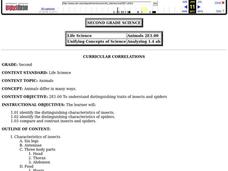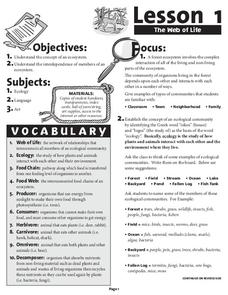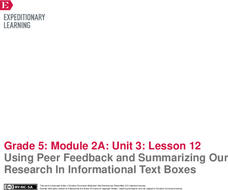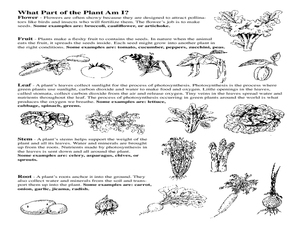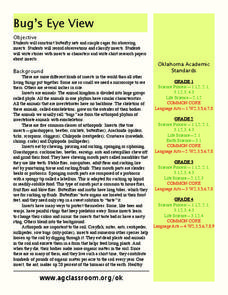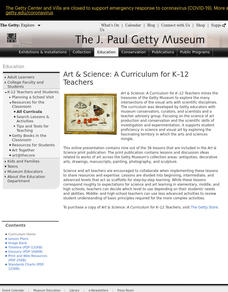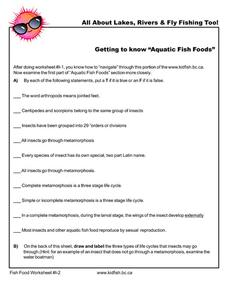Curated OER
Animals
Second graders explore the ways in which animals differ. They discuss the characteristics of insects and spiders. Students identify the characteristics of insects and spiders. They compare and contrast insects and spiders.
Curated OER
Introduction To Bug Collecting
Students explore process of live collection of insects and spiders using sweep nets, aerial nets, and beating sheets. they collect, examine and release several different types of insects or spiders then compare their journal drawing of...
Curated OER
Creepy Crawlies
Students investigate various insects through different activities. They read the book, The Very Hungry Caterpillar by Eric Carle. They recite nursery rhymes and play Bingo with pictures of insects. They consider insect-related poems...
Curated OER
The Flower and the Fly
It's like a biological "Beauty and the Beast!" The fascinating mutualism between a South African meganosed fly and a deep-throated geranium builds a case study in coevolution for your biology buffs to analyze. After reading about this...
Desert Discoveries
Sonoran Desert Predators and Prey
Here is a fabulous lesson the animals found in the Sonoran Desert. Learners classify these animals as predators, prey, or both! They take a look at the many adaptations that these animals utilize to help them find food, and avoid...
Curated OER
Harvesting Mosaics
Students use pieces of farm pictures to investigate the elements of art. In this farm art instructional activity, students use pieces of pictures to create an original artwork. Students use the Internet to find images. Students create...
Forest Foundation
Forest Health
Young foresters examine the strategies, like prescribed burns and thinning, that are employed to ensure healthy forests.
Forest Foundation
The Web of Life
Producers, herbivores, carnivores, omnivores, decomposers. To begin a study of the forest ecosystem, learners examine the connections among the members of ecological communities.
Curated OER
A Whole Lotta Changin' Goin' On
Here's a fabulous activity on the life cycle of a butterfly. Youngsters are able to identify and understand the four stages of life. They construct models of a caterpillar and write a sequence story about the life of a butterfly. This...
Curated OER
Giant Smelly Plant Attracts Thousands
Read and discuss a news article about a rare corpse plant that bloomed in Washington D.C. Because this native Indonesian plant blooms so rarely, people flock to see it. After reading the article, your class answers comprehension...
Captain Planet Foundation
Energy Flow in the Garden
How can you tell what an owl has eaten? Study the food chain and flow of energy in an ecosystem by dissecting an owl pellet and noting the bones found inside. Additionally, the lesson includes a game about consumers and producers with a...
EngageNY
Using Peer Feedback and Summarizing Our Research In Informational Text Boxes
Insert text box here. Learners use index cards to create their own informational text boxes. The text box includes information about an insect in the rainforest. Scholars also complete the draft of their research science journal entries.
Reed Novel Studies
James and the Giant Peach: Novel Study
Everyone wants to feel like they belong. James, in James and the Giant Peach, finds a feeling of belonging in a very odd place—inside a peach! Scholars read the story of James and the Peach and work through vocabulary, language, and...
Curated OER
Termite Biology
Students explore the physical characteristics, distribution and habitat of termites. The lesson focuses on the termite as a social creature contrary to most other insects.
Curated OER
Ask the Antlion
Middle schoolers observe and examine the life cycle of antlions, recording their observations of the live insects in a journal. They view an antlion on a video microscope, draw the body parts, and replicate their experiment at home.
Curated OER
Plant Party
Students identify plant parts. In this plants lesson, students bring in a vegetable. Each student classifies which part of the plant their vegetable comes from (flower, root, ect.) Students identify the parts of their vegetable and later...
Curated OER
Caterpillar Camouflage
Students list animals, plant parts, and reasons for caterpillars to camouflage themselves. For this animal and plant adaptations lesson plan, students also play a game where they use colors as camouflage.
Curated OER
Bug's Eye View
Pupils explore biology by writing fictitious stories in class. In this insect life lesson, students identify many different types of insects in the animal kingdom and the classifications they fall into. Pupils collect insects on a field...
Curated OER
Life Cycle
Third graders examine and compare the life cycles of a variety of different animals. They analyze photos of animals and discuss any unique body parts and why those parts function they way they do. Next, they observe mealworms and...
Curated OER
Bug Hunt
Students examine the different characteristics of bugs in their local area. They take characteristics of bugs they have observed and create their own new insect. They draw their new bug and share it with the class.
Curated OER
"What Insecit Am I"
Learners play the game "What Insect Am I" to explore the parts of an insect and their habitats.
Curated OER
Clearly Classified
Learners investigate plants and insects. In this science classification lesson plan, young scholars create separate categories for insects and plants by characteristics. Learners discover scientific names of insects.
Curated OER
Life in a Log
Students identify insects living in rotting logs. For this decomposition lesson, students observe pieces of a rotting log, they look at the insects that have inhabited the log and create a chart that shows their findings.
Curated OER
Getting to Know "Aquatic Fish Foods"
In this fish worksheet, students access a website to learn more about the common insects eaten by fish. Then students draw and label three types of insect life cycles. This worksheet has 10 true or false questions and 3 drawings.


